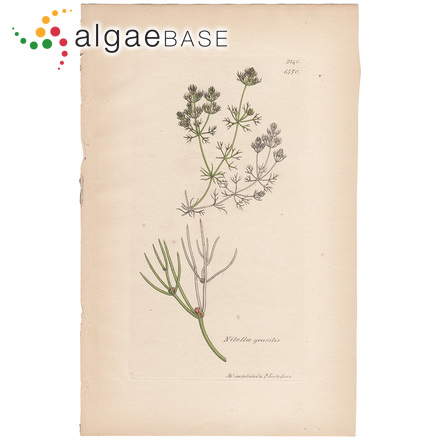Nitella gracilis (J.E.Smith) C.Agardh 1824

Current name:
Nitella gracilis (J.E.Smith) C.Agardh
Another copy of pl. 2140 from Smith's English Botany, less coloured - 30 April 2020. Out of copyright
Publication Details
Nitella gracilis (J.E.Smith) C.Agardh 1824: 125
Published in: Agardh, C.A. (1824). Systema algarum. pp. [i]-xxxvii, [1]-312. Lundae [Lund]: Literis Berlingianis [Berling].
Publication date: probably September 1824
Type Species
The type species (lectotype) of the genus Nitella is Nitella opaca (C.Agardh ex Bruzelius) C.Agardh.
Status of Name
This name is of an entity that is currently accepted taxonomically.
Basionym
Chara gracilis J.E.Smith
Type Information
Type locality: St. Leonard's forest, Sussex [England]; (Smith 1809-1810: pl. 2140) Holotype: Mr W. Borrer; Sept 4, 1809; boggy pool; BM; (Smith 1809-1810: pl. 2140) Notes: The Borrer BM specimen was dsignate as "Lectotype" by Heiko Korsh in Arbeitsgruppe Armleuchteralgen Deutschland (2015: 435). While Smith mentions other material, the description and plate is more likely based on the material from Sussex, which constitutes a "single gathering."
Origin of Species Name
Adjective (Latin), thin, slender (Stearn 1983).
General Environment
This is a freshwater species.
Description
The plants are to 20 cm high, slender. The axis is less than 0.5 mm in diameter. The branchlets are divided 2 or 3 times. The end segments (rays) are 2-3 celled. The end cells are tapering (they are as broad as the penultimate cells). The species is monoecious. The oogonia are small, up to 450 µm long and 400 µm wide. The oospore is dark brown and has a granulate membrane. The antheridia are between 200-300 µm in diameter.
Habitat
Nitella gracilis is a freshwater species, and it is found in many types of habitats; Lobelia-lakes, mesotrophic lakes or in small waters like ditches, pits and ponds. The species has most common been found in shallow water.
N. gracilis is reported both as annual and perennial, but is most probably annual it this area (Olsen 1944).
The plants are fertile from June and onwards, and ripe oospores have been found from August to October.
Created: 11 April 2002 by M.D. Guiry.
Last updated: 09 August 2022
Verification of Data
Users are responsible for verifying the accuracy of information before use, as noted on the website Content page.
Linking to this page: https://www.algaebase.org/search/species/detail/?species_id=35596
Citing AlgaeBase
Cite this record as:
M.D. Guiry in Guiry, M.D. & Guiry, G.M. 09 August 2022. AlgaeBase. World-wide electronic publication, National University of Ireland, Galway. https://www.algaebase.org; searched on 11 January 2025
 Request PDF
Request PDF














